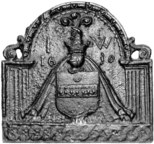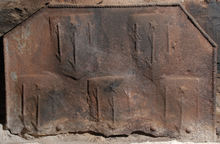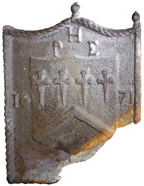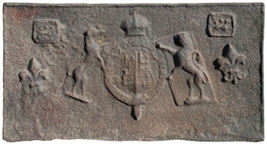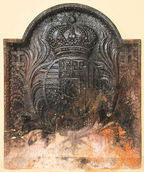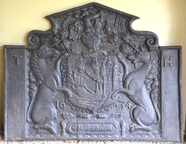-
691
Description: Arched rectangle; arch with egg and dart, ovolo edging, resting on rectangle shoulders and sides with triple fillet edging, a single fillet edged panel beneath; bottom panel, guilloche pattern of 12; main panel: shield, helm, crest, coronet and mantling of the Wynter/Wintour family of Lydney, Gloucestershire; the initials above the date, both split by the helm and coronet; on either side of the shield, Ionic pilasters; above the rectangle shoulders, a scrolled bracket each side, supporting the arch.
Notes: Wynter: Sable, a fess ermine, in chief a crescent for difference; crest: out of a ducal coronet, or, a cubit arm in armour erect, proper, garnished of the first, in the gauntlet three ostrich-feathers. The arms are likely to be those of Sir John Wynter, who owned several furnaces in the Forest of Dean. Formerly at Watts House, Bishop's Lydeard, Somerset, and before that at The Priory, Taunton.
Inscription: I W / 16 30
Arms: Winter/Wintour of Lydney, Gloucestershire
- Decoration tags:
- rectangular with round arch (shape)
- ovolo, egg and dart (edging)
- whole carved pattern
- individual letters
- individual numbers
- armorial
- text
Manufactured: in 1630 in the Forest of Dean area of England.
Current location: Horniman Museum, 100 London Road, Forest Hill, London, England.
Museum number: 6.249 (part of the Horniman Museum museum group)
- Attached to series:
- Personal armorial firebacks
- Date & initials firebacks
-
959
Description: Arched shape; twisted rope edging (top and sides); top centre, shield of impaled arms; date above shield; initials, in triad ('F above), to right of shield.
Notes: The arms are of Sir Peter Frecheville (1575-1634) of Staveley Hall, Derbyshire, and his first wife, Joyce Osborne, née Fleetwood (d.1619), whom he had married in the year of the fireback's casting; the blazon is as follows: (Frecheville) Azure, a bend between six escallops argent; (Fleetwood) Per pale nebuly or and azure, six martlets, two, two and two counterchanged (the tinctures, as painted, are incorrect). At the bottom of the fireback there appears to be the remains of a runner by which the molten iron flowed into the sand mould.
Inscription: 1605 / PFI [triad]
Arms: Frecheville impaling Fleetwood
- Decoration tags:
- rounded arched (shape)
- rope (edging)
- whole carved pattern
- individual letters
- individual numbers
- armorial
- text
Manufactured: in 1605 probably at Staveley Furnace in the Derbyshire area of England.
Current location: Staveley Hall, Staveley Hall Drive, Staveley, Derbyshire, England.
- Attached to series:
- Personal armorial firebacks
- Date & initials firebacks
-
692
Description: Rectangular with inclined sides, joined by scrolls to a pedimented top; twisted rope edging (top and sides); Garter enclosing the Tudor royal arms, with crowned lion and dragon supporters, helm with chapeau and lion crest, and mantling; rectangular date compartment at base; initials either side of crest.
Notes: The detached pediment is stylistically typical of the late-16th and early-17th centuries. The use of a chapeau or cap of maintenance in place of a crown above the helm is rare in this period. There is an excrescence on the casting over the jaws of the dragon caused by the pouring of the molten metal disturbing the sand mould.
Inscription: E R / Garter motto / 160[?0]
Arms: Tudor royal - Elizabeth I
- Decoration tags:
- rectangular with detached pediment (shape)
- rope (edging)
- whole carved pattern
- individual letters
- individual numbers
- armorial
- royal
- text
Manufactured: in 1600 in England.
Current location: Cothay Manor, Stawley, Somerset, England.
- Attached to series:
- Elizabethan royal armorial firebacks
- Tudor royal armorial firebacks
-
693
Description: Canted rectangle; twisted rope edging (top and sides); a shield repeated five times, each bearing three arrows palewise, points down, with a molet (star) above the middle arrow, two over three.
Notes: Three arrows form the arms of several families, so identification of the arms is not possible without the associated colouring. The star is likely to be a mark of cadency, granted to a third son. Four rivets along the base may relate to earlier repair. The fireback was formerly at Chisenbury Priory, Wiltshire. A variant with three shields (W 740mm x H 480mm) was lot 530 at Brettells auction, Newport, Salop, 1 March 2022 and again as lot 457 on 2 May 2023.
Arms: Not known
- Decoration tags:
- rectangular with canted top corners (shape)
- rope (edging)
- carved stamps
- armorial
Manufactured: in the late-16th to early-17th century in England.
Current location: Cothay Manor, Stawley, Somerset, England.
- Attached to series:
- Personal armorial firebacks
-
1078
Description: Fragment; quasi-arched rectangular shape; twisted rope or leather edging; flame on centre arch and on top corners (left missing); initials in triad above central shield with date split either side of centre; the bottom right corner is missing.
Notes: The initials are of Philip Hollins (d. 1724) of Mosslee Hall, Cheddleton, Staffordshire, and his wife Elizabeth Bage whom he married in 1671. Blazon: Argent, a chevron azure, in chief four crosses formee fitchee of the second.
Inscription: PHE [triad] / 16 71
Arms: Hollins, of Mosslee Hall
- Decoration tags:
- rectangular (shape)
- rope (edging)
- whole carved pattern
- heraldic
- armorial
- text
Manufactured: in 1671 possibly in the Staffordshire area of England.
Current location: The Potteries Museum and Art Gallery, Bethesda Street, Stoke-on-Trent, Staffordshire, England.
Museum number: LH.SH.1955.21 (part of the Stoke-on-Trent Museums museum group)
- Attached to series:
- Personal armorial firebacks
-
1021
Description: Rectangular; cavetto-moulded edging; shield mounted on a strap-work cartouche, helm, crest, motto scroll and elaborate swirled mantling.
Notes: The arms of the Ironmongers' Company; blazon: Argent, on a chevron gules, between three gads of steel azure, three swivels or; crest: two talbots combatant encoupled together or. The true crest of the company has two salamanders (originally 'scaly lizards') rather than talbots, and it has been noted on other firebacks that salamanders are not always represented as amphibians; Samuel Lyne, in his Heraldry Display'd (1741), described the crest as 'two talbots', etc. The motto scroll is blank, indicating that the pattern was an armorial panel with a painted, rather than a carved, motto. A variant of the same fireback has the date 1660 and initials GI (Country Life, 8 March 1946, p. 450; 29 March 1946, p.588). Reeman Dansie auction, Colchester, 13 Apr 2016, lot 1224; Bellman's auction, Wisborough Green, 13 Oct 2021, lot 588 (£220).
Copies of this fireback are known.
Arms: Worshipful Company of Ironmongers
- Decoration tags:
- rectangular (shape)
- cavetto (edging)
- whole carved pattern
- armorial
Manufactured: in the mid-17th century in England.
Current location: not known.
- Attached to series:
- Livery company firebacks
- Armorial panel firebacks
-
470
Description: Rectangular; twisted rope edging (top and sides); central Tudor royal shield with encircling garter (motto reversed), separate greyhound and lion supporters, separate crown; rectangular bordered stamp with an animal facing to the right, repeated once above and on each side of the armorial; bold fleur-de-lys stamp repeated once on each side of the armorial below the other stamp; all irregularly positioned.
Notes: The armorial and fleurs-de-lys are seen together on a plate at Alfriston Clergy House.
Copies of this fireback are known.
Arms: Tudor royal (prob. Henry VIII)
- Decoration tags:
- rectangular (shape)
- rope (edging)
- carved stamps
- heraldic
- armorial
- royal
- objects
Manufactured: in the early- to mid-16th century possibly at Pounsley Furnace, Framfield in the Weald area of England.
Current location: not known.
Citation: Lloyd, N., 1925, 'Domestic Ironwork I', Architectural Review, 58, pp. 58-67.
- Attached to series:
- Pounsley series
- Tudor royal armorial firebacks
-
820
Description: Arched rectangular shape; wide fillet and egg-and-dart ovolo edging; central oval armorial with fillet edging, palm fronds on each side, tied below, a crown above; in each top corner, the cross of Lorraine.
Notes: The arms are those of Duke Leopold I of Lorraine, who also bore the titles of King of Jerusalem, Hungary and Aragon, and Duke of Anjou, Bar, Gueldre and Juliers.
Arms: Leopold I, Duke of Lorraine and Bar (1680-1729)
- Decoration tags:
- rectangular with round arch (shape)
- ovolo, egg and dart (edging)
- whole carved pattern
- armorial
Manufactured: in the early-18th century possibly in the Lorraine area of France.
Current location: not known.
- Attached to series:
- Foreign armorial firebacks
-
952
Description: Rectangular joined to pediment by symmetrical scrolls; fillet edging with embattling inside; shield, helm, crest, supporters and mantling of the city of Bristol; date split by bottom of shield; inscription in an oval cartouche below shield; rectangular side extensions with twisted rope edging; initial on each extension.
Notes: The mismatched ‘3’ in the date is likely to have replaced a ‘1’ or ‘2’. The pattern-maker was also responsible for carving royal coats of arms in three West Country churches and a small number of series of firebacks in the first quarter of the 17th century.
Inscription: T H / 16 34 / ARMES BRISTOLL
Arms: City of Bristol
- Decoration tags:
- rectangular with detached pediment (shape)
- fillet and rope (edging)
- whole carved pattern
- individual letters
- individual numbers
- planklines
- extension panels
- armorial
- text
Manufactured: in 1634 possibly in the Forest of Dean area of England.
Current location: not known.
- Attached to series:
- Civic firebacks
- Bristol armorial series
-
699
Description: Rectangular; twisted rope edging on top and sides; cavetto-moulded-edged rectangle top centre, enclosing date between initials; 16 shields of Ayloffe impaling Sulyard in three rows (5-6-5); Ayloffe: sable, a lion rampant Or, collared gules, between three crosses formy of the second; Sulyard: argent, a chevron gules between three pheons inverted sable.
Notes: William Ayloffe (c1535-1584) of Bretons, Hornchurch, Essex, Justice of the Court of Queen’s Bench, married (c1560) Jane, dau. of Sir Eustace Sulyard, of Runwell, Essex. The initials 'CT' are likely to be those of Charles Tyler, a founder whose working life and that of his family have strong parallels with the occurrence of these firebacks. An identical fireback is in a house at Cowden, Kent, and a broken example is at Wool House, a National Trust property at Loose also in Kent; small variations in the alignment of the shields are apparent.
Copies of this fireback are known.
Inscription: C.1.6.0.1.T
Arms: Ayloffe impaling Sulyard (William Ayloffe of Bretons, Hornchurch)
- Decoration tags:
- rectangular (shape)
- rope (edging)
- carved stamps
- individual letters
- individual numbers
- armorial
- text
Manufactured: in 1601 possibly at Bedgebury Furnace, Goudhurst in the Weald area of England.
Current location: not known.
- Attached to series:
- Ayloffe series
- Personal armorial firebacks
